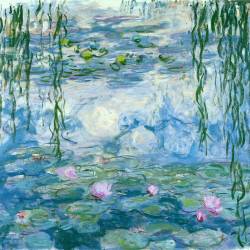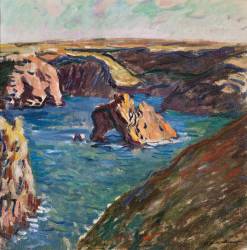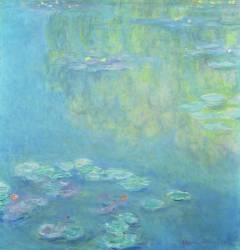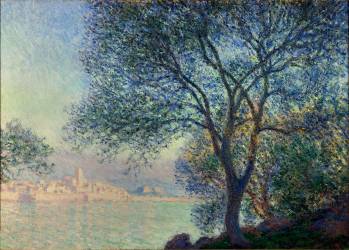Artwork of Claude Monet canvas prints & artprints
Considered the father of French Impressionism, Claude Monet is best known for his Water Lilies, a series of around 250 paintings depicting his garden at Giverny. An innovative painter, he embodied the transition to modern art and is without doubt one of the major figures of the 20th century.
Muzéo offers over 900 works by Claude Monet in its catalog, from the best-known such as "Impression, soleil levant" or "Les Nymphéas", to the most intimate such as our favorite painting: "Femme à l'ombrelle - Madame Monet et son fils".
Decorate your home in the Impressionist style with Monet reproductions.
Claude Monet biography: everything you need to know about the father of French Impressionism
The genesis of an artist: from turbulent schoolboy to painting genius
From childhood, Claude Monet (1840-1926) drew caricatures in the corner of his notebooks, to the detriment of his studies, which he abandoned in 1857, on the death of his mother. His aunt, herself an artist, took him in hand and encouraged him to sell his caricatures to a shopkeeper in Le Havre, where Eugène Boudin also exhibited. Eugène Boudin was attracted by the work of the young artist, who was barely 20, and advised him to paint landscapes, en plein air, following his example. From then on, landscape painting was a genre he never abandoned. In 1862, he left Le Havre and entered the studio of the Ecole Impériale des Beaux-Arts in Paris, where he met Auguste Renoir, who was to remain his faithful friend for the rest of his life. However, the return to Antiquity advocated by the school did not appeal to the young artists, who left the studio for good.
This was followed by several years of financial troubles and depression, during which he exhibited a few works at the Salon, without much success. In 1874, he took part in an exhibition held by the photographer Nadar in Paris, where he exhibited his painting Impression, Soleil Levant. Following Louis Leroy's criticism of his painting, the name "Impressionist" was coined.
The beginning of fame threatened by financial troubles
With a second Impressionist exhibition in 1876, Monet's career took off: the critics were at last enthusiastic! A third exhibition took place the following year, featuring eight paintings from his series on the Gare Saint-Lazare in Paris. Unfortunately, despite his success, the artist was drowning in debt and often saved his paintings from seizure in extremis. Although the great art dealer Paul Durand-Ruel supported him throughout his career, he was forced to return to live near his family, where his aunt supported him.
The painter's technique was based on observing the laws of optics and using the decomposed colors of the prism, drawing inspiration from Newton's work in particular, while eliminating black and gray from his palette: he rejected the overly academic approach to landscape.
Claude Monet's love life was no picnic either...
The painter's love life was not always easy to follow... In 1866, he met Camille Doncieux, who became his model and then his lover. A year later, she gave birth to his first son, Jean. Camille and Claude married in 1870, at a time when the painter's financial health was at its lowest, and moved to Argenteuil. The couple then moved in with another couple, the patron Ernest and his wife Alice Hoschedé, with whom the artist had an affair. Two years later, Camille gave birth to a second son, Michel. She never really recovered, and died the following year. The painter now lives alone with his two sons, the Hoschedés and their six children. Ernest was often away on business, however, and the lifestyle of this strange family caused a scandal.
On Ernest's death, Claude and Alice married, raised their eight children together, and moved into a house in Giverny, which also became the painter's studio.
Finally, at the end of his life, he is said to have had an affair with Blanche Hoschedé, daughter of Alice Hoschedé and widow of his own son Jean.
From Rouen Cathedral to Water Lilies, discover Monet's serial works
Depicting a landscape at different times of day, changing the way light affects the environment, was one of the hallmarks of the Impressionists, and Monet was no exception. Among his best-known paintings in series are La Gare Saint-Lazare in Paris, the Thames in London and Rouen Cathedral, all oil on canvas.
But his best-known series remains the Water Lilies, representations of his garden, which he modeled over the years. They were shown at two highly successful exhibitions in 1900 and 1909. During the First World War, the last decade of his career, the painter retreated to his house/workshop in Giverny. His garden, and in particular his pond, became his main source of inspiration. Encouraged by his friend Clémenceau, he produced a series of decorative oil panels on the theme of the Water Lilies, for the Musée de l'Orangerie in Paris.
A tragic end: visually impaired and in mourning, Claude Monet continued to paint until his death.
From 1909 onwards, Claude Monet's life changed completely. Back in France after his trip to Venice, his wife Alice became seriously ill and died two years later. His son Jean died in 1914. In the meantime, he was diagnosed with a double cataract, affecting his color perception. For a long time, he refused to undergo surgery, but under pressure from his friend Clémenceau finally agreed to do so. In 1919, he lost his dear friend Renoir, and shortly afterwards his art dealer Paul Durand-Ruel. His eyesight deteriorated again, and he could hardly work.
Weakened by incessant work and lung cancer, the artist died on December 5, 1926, in Giverny, France. He was responsible for a great change in the history of art: the creation of Impressionism. Today, his paintings can be seen mainly at the Musée du Louvre, the Musée Marmottan-Monet, the National Gallery in London, the MET Museum and the Art Institute of Chicago.
Learn more about the life and the works of Claude Monet.
















































































































































